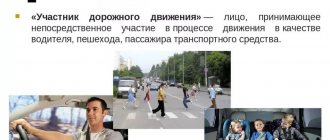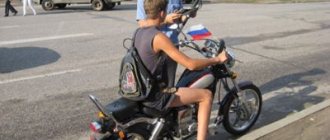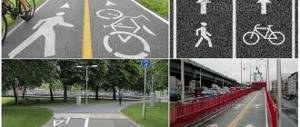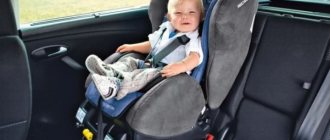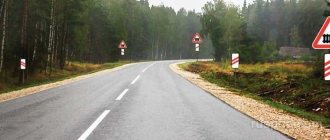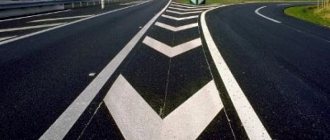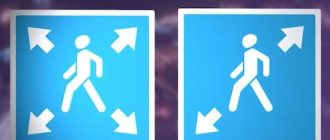Drivers' responsibilities
1. The driver of a mechanical vehicle must have with him, and at the request of police officers, hand over to them for inspection:
Driver's license
- a driver's license of the category that corresponds to the category of the vehicle. Vehicles of category A include motorcycles, and vehicles of category B include cars and trucks with a permissible maximum weight of no more than 3.5 tons, in which the number of passenger seats provided for by design is no more than eight;
- registration documents (registration certificate) for the vehicle, and if there is a trailer, also for the trailer;
- insurance policy of compulsory motor third party liability insurance (MTPL);
- in specially specified cases - other documents provided for by the Rules.
Fasten your seat belt
2. When driving a vehicle, be wearing a seat belt and ensure that passengers, including those riding in the rear seats of a car, also wear their seat belts.
When driving a motorcycle, wear a fastened motorcycle helmet and do not carry passengers without a fastened motorcycle helmet.
3. Before leaving, check and ensure that your vehicle is in good technical condition on the way.
4. At the request of police officers, undergo an examination for intoxication, which can be carried out at the place of the stop or in a drug laboratory.
5. Provide your vehicle in cases provided for by law:
- police officers;
- employees of federal state security agencies;
- FSB employees;
- medical and pharmaceutical workers to transport citizens to the nearest medical facility in cases that threaten their lives.
The right to stop a vehicle is granted to traffic controllers. Persons who have the right to stop a vehicle are required to present a service ID or license plate upon the driver’s request.
Where can you cross the road?
A trivial question, but it can be explained in great detail. Everyone knows that if the traffic light turns green at the crossing, then you can go. This knowledge is not enough. It is for this reason that many people now take road tests to understand how competent pedestrians they are.
Well, transitions can be both unregulated and vice versa. The traffic light is regulated. On the rest there is no sign, but only a crossing sign and a zebra crossing.
It is important to know that even if the traffic light turns green, it is better to wait a couple of moments, look around and cross. There is no need to think: “The color has changed, you can calmly go and not worry - I’m right!” Yes, the pedestrian is right. It’s just possible that the car passed the traffic light and the driver didn’t see the color change. Having noticed a person on the zebra crossing, he began to slow down, but... everyone knows that the stopping distance is a couple of tens of meters. So there's no need to rush. Better to protect yourself.
If this is an intersection and there is no crossing there, then you can cross along the line of sidewalks or curbs - the rules allow this. What if there is neither one nor the other? The traffic rules (traffic rules) have provided for this case. In such situations, a person has the right to cross the road at a right angle in an area where there are no fences or dividing strips. Be sure to move to the edge of the roadway. And the area should be visible in both directions.
The driver is prohibited
Driving a vehicle while intoxicated
- drive a vehicle in a state of alcohol, drugs or other intoxication, under the influence of medications that impair attention and slow reaction, in a painful or tired state that jeopardizes traffic safety;
- transfer control to persons in such a state;
- use intoxicating substances between the commission of an accident and the passage of an examination for intoxication, or between a stop for the purpose of conducting an examination and its implementation;
- transfer control to persons who do not have a driver’s license or are not included in the MTPL insurance policy;
- cross organized transport and foot columns and take place in them;
- drive a vehicle in violation of the work and rest schedule;
- use while driving a telephone that is not equipped with a “hand-free” technical device that allows you to negotiate without using your hands.
Class hour “Responsibilities of pedestrians, drivers, passengers”
Class hour “Responsibilities of pedestrians, drivers, passengers”
Goal: To deepen students’ knowledge of traffic rules. To form schoolchildren’s ideas about road safety when moving along streets and roads. To develop skills in following the basic rules of behavior for pedestrians, passengers, and drivers on the street and road, in order to prevent road traffic injuries. Equipment: media projector, computer, electronic application for class, traffic rules. Relevance: Main causes of accidents: traffic violations by drivers - 74.3%, traffic violations by pedestrians - 30.8%, unsatisfactory condition of streets and roads - 22.7%, technical malfunctions of vehicles - 2.5%. Plan. 1.Opening speech by the teacher. 2. Familiarity with the responsibilities of pedestrians. Expert: According to statistics, of the total number of road accidents, half involve pedestrians. This is a terrible indicator, indicating the low culture of both pedestrians and drivers. For comparison: in Sweden, accidents involving pedestrians are only 7.3%, but in Romania - 56%. It turns out that pedestrians hate the right moment to cross the road. Half are willing to stand on the sidewalk for just 4 seconds, while the fifth are willing to risk their lives to end up on the opposite side of the road. We must fight such impatience, remembering that the one who “hurries slowly” comes first. About "Zebra". A striped path only to some extent guarantees your safety on the road. Scientists have found out. That seven out of ten drivers talking on a cell phone will not give way to pedestrians at a zebra crossing. And in Belgium, for example, as soon as a pedestrian approaches the edge of the road, all the cars stop until the person completely crosses the roadway. In the West, the International Pedestrian Federation has even been created. On her initiative, the European Parliament adopted the Charter of the Rights of Pedestrians. It contains the following lines: “A pedestrian has the right to an urban area intended exclusively for use, and as large as possible, harmoniously fitting into the overall layout of the city.” Critic: We also have pedestrian zones, for example, Arbat in Moscow, but this only a separate plot in the city center. But in Tallinn the entire old town has been declared a pedestrian zone. Is there such a pedestrian zone in our city? Presenter 1: We must hope that in Russia there will be more and more safe zones where pedestrians can freely and safely enjoy life. Let us remember how Ilf and Petrov said this in “The Golden Calf”: “You have to love the pedestrian... Pedestrians created the world. They built cities... And when everything was ready. When the home planet took on a relatively comfortable appearance, motorists appeared. We must assume that the car was also invented by pedestrians. But motorists somehow immediately forgot about it.” Traffic rules expert: Now let's get acquainted with the responsibilities of pedestrians: 1. Pedestrians must move on sidewalks or pedestrian paths, and in their absence, along the shoulders. When moving along the edge of the roadway, pedestrians must walk towards the movement of vehicles. When driving along the side of the road or the edge of the roadway in the dark or in conditions of insufficient visibility, pedestrians are recommended to carry objects with reflective elements and ensure that these objects are visible to vehicle drivers. 2. The movement of organized pedestrian columns along the roadway is permitted only in the direction of movement of vehicles on the right side of no more than four people in a row. In front and behind the column on the left side there should be accompanying persons with red flags, and in the dark and in conditions of poor visibility - with lights on: white in front, red in back. Groups of children are allowed to be driven only on sidewalks and pedestrian paths, and in their absence - and along the roadsides, but only during daylight hours and only when accompanied by adults. 3. Pedestrians must cross the roadway at pedestrian crossings, including underground and overground ones, and if there are none, at intersections along sidewalks or roadsides. 4. In places where traffic is regulated, pedestrians must be guided by the signals of a traffic controller or a pedestrian traffic light, and in its absence, a transport traffic light. 5. At unregulated pedestrian crossings, pedestrians may enter the roadway after assessing the distance to approaching vehicles, their speed and making sure that the crossing will be safe for them. 6. Once on the roadway, pedestrians should not linger or stop unless this is related to ensuring traffic safety. Pedestrians who do not have time to complete the crossing must stop on the line dividing traffic flows in opposite directions. You can continue crossing only after making sure that further movement is safe, and taking into account the traffic light signal (traffic controller). 7. When approaching vehicles with a blue flashing light and a special sound signal on, pedestrians are required to refrain from crossing the roadway, and those on it must give way to these vehicles and immediately vacate the roadway. 8. Waiting for a fixed-route vehicle and a taxi is allowed only on landing platforms raised above the roadway, and if there are none, on the sidewalk or side of the road.3. Responsibilities of passengers. Traffic rules expert: Passengers' responsibilities are not as numerous as drivers', but in any case they exist. In this case, the driver is responsible for their implementation on the part of passengers. 1. Passengers are required to wear the required seat belts, regardless of where they are located; 2. Boarding or disembarking should be done from the sidewalk or curb, making sure that it is safe and does not interfere with other road users. 3. Passengers are prohibited from opening doors while driving and distracting the driver from driving. Critic: All the listed requirements and prohibitions are childishly naive, but there are plenty of examples of their failure to comply. A fairly common occurrence: a passenger opens the door from the side of the roadway and safely drives away in a passing car, but not fastened seat belts is not a topic for conversation at all... 4. Responsibilities of the driver. Presenter 2: Today we will talk to you about more adult things - about cars. The time is not far when this miracle of technology will be in every family. I am convinced that you are already looking with interest at your father’s or mother’s car, imagining yourself behind the wheel. You won't have to wait long, a few years will pass, and you will graduate from school and receive a driver's license. Legally press the pedal of the car. Presenter 1: That’s why I’m turning to you now, as future equal road users, in the hope that you will learn the necessary truths today, moreover, that you will help consolidate them in the minds of your parents. Expert: Let’s start with the seat belt. Tell me, do your parents always wear seat belts? Not always. Unfortunately, more than a hundred citizens, who are missing every day in Russia, also neglected seat belts... And if they all wore seat belts, this terrible figure would be reduced by two thirds. Critic: What happens to drivers and passengers if they are not wearing seat belts at a speed of 80 km. do they run into a tree or a wall per hour? 0.03 seconds after the impact, the bumper is pressed in; a force 30 times the weight of the car. Stops its movement in the line of the front seats; at the same time, passengers continue to move by inertia at a speed of 80 km. at one o'clock. Seconds later, the driver breaks the steering wheel with his chest and hits the dashboard with a force of 9 tons. Then the driver and the passenger next to him hit their heads on the windshield... It’s probably enough that it’s clear that no one will survive. If the driver and passenger were wearing seat belts, they had a real chance of survival. Presenter 2: In general, seat belts are far from useless in a car. It’s not for nothing that Formula I world champion Ralf Schumacher wears his seat belt, even when he needs to drive his car from home to the garage. And it’s only thirty meters to go. In a word, fastened seat belts all over the world are as commonplace as a toothbrush. Expert: Progress does not stand still. Devices are already being produced that warn the driver with an audible signal about the need to buckle up. Moreover, there are seat belts that automatically fasten the driver and passengers. In the meantime, remind dad to buckle up. This makes it more likely that your family will gather together for dinner. Traffic rules expert: I think it’s not worth mentioning that the driver is obliged to know and follow the Rules of the Road, and besides this: · have a driver’s license, registration certificate, compulsory civil liability insurance policy; · wear a seat belt and not carry passengers who are not wearing seat belts; · ensure the serviceability of the vehicle before leaving and during the movement; · undergo an intoxication examination at the request of police officers; Presenter 1: Today we are trying to figure out what we are doing wrong on the road. Let's not forget the most common vehicle available to schoolchildren - a bicycle. Presenter 2: Let's remember the first thing: this is the most unprotected vehicle. It does not have doors that protect against side impacts, and there is no bumper that would partially absorb a frontal impact. Therefore, in any collision or collision with an obstacle, the cyclist is very vulnerable. But you need to take care of yourself - full-fledged spare parts for humans have not yet been invented. Presenter 1: Second: it is comfortable to ride a bicycle where a special safe zone has been created for this. Since there are very few such areas, try to prevent any potential danger. For example, you left the entrance and got on your bike. His tires are inflated, his brakes are good, and his lights are in place. And not far from you, a man gets into a car and his further actions are still unknown to you. Wait for the car to move and let it pass. Another example, you are driving through the yard and turn into the arch of a house. You don’t know what awaits you there, so slow down and slow down when entering the arch. Presenter 2: Third rule: never try to pass between a moving and a standing car. Stop and let the car coming towards you pass. Don't take this as cowardice, it's just common sense. An elementary sense of self-preservation. Traffic rules expert: Now the main thing: try not to drive onto the roadway, even if you are over 14 years old. Teacher: Today we learned how to behave while driving a bicycle or a car, we studied the duties of a pedestrian and a passenger, and we understood the main thing - you should not expose your life to unjustified risk. Being careful on the road is not cowardice, but calculation.
Driver's actions in case of an accident
In case of a traffic accident with injured or killed, the driver involved in it is obliged to:
Put up a warning triangle
- Stop immediately, turn on your hazard lights and display a warning triangle. Do not move objects related to the incident.
- Call an ambulance or rescuers (from a mobile phone - call 112). Before their arrival, provide first aid to the victims. In exceptional cases, it is allowed to send the victims to the nearest medical facility in a passing vehicle or in their own vehicle. In the latter case, after delivering the victim to the hospital, the participant in the accident is obliged to return to the scene of the accident.
- Report the incident to the police (from a mobile phone - call 112). Write down the names and addresses of eyewitnesses and wait for the police to arrive. The roadway can only be cleared upon command from the police. However, if the movement of other vehicles is impossible, then the driver must record in the presence of witnesses all traces and objects related to the incident and organize a detour around them. After this, you can clear the roadway.
- Notify your insurance company about the accident. After registering an accident, police officers, together with other participants in the incident, fill out a Notice of Road Accident. Subsequently, the completed notice is submitted to the insurance company along with documents prepared by the police:
- a copy of the accident certificate;
- a copy of the protocol on the administrative offense;
- a copy of the resolution in the case of an administrative offense.
Road accident without injuries
Road accident without injuries
In case of an accident without injuries, steps 1, 3 and 4 must be followed. Before the police arrive, you should carefully inspect the scene of the accident and the damage to your vehicle.
The information you collect can be very useful when filing an accident.
If there are no victims in an accident and there are no disagreements between its participants, then instead of calling the traffic police, it is allowed to independently come to the nearest traffic police post or police department with a road accident diagram drawn up and signed by both participants.
Since the road accident diagram is evidence in a traffic accident case, you can sign it only after making sure that everything depicted on the diagram corresponds to reality.
If only two vehicles are involved in an accident without casualties, the owners of which have valid MTPL policies, and there are no disagreements about the circumstances of the incident and the nature of the damage caused, it is permissible not to involve police officers in registering the incident, but to confine oneself to filling out an Accident Notice so that the insurance company compensates the victim harm caused.
At the same time, the victim must keep in mind that with a simplified registration procedure, the maximum possible amount of compensation is 25 thousand rubles. If the preliminary assessment of the damage caused exceeds this amount, it is necessary to register an accident with the involvement of traffic police officers.
Passenger Responsibilities
1. Passengers are obliged to:
- when traveling in a vehicle, wear seat belts, and when riding a motorcycle, wear a fastened motorcycle helmet;
- boarding and disembarking from the car should be done from the sidewalk or curb and only after a complete stop. Boarding and disembarking from the side of the roadway is permitted provided that it is safe for the passenger and does not interfere with other road users.
2. Passengers are prohibited from:
- distract the driver while driving;
- when traveling on a truck with a flatbed, stand, sit on the sides or on a load above the sides;
- open the doors of the vehicle while it is moving.
General responsibilities of pedestrians and passengers
For all categories of road users there are rules that must be followed by everyone, regardless of status. The general responsibilities of pedestrians and passengers are enshrined in the traffic rules. These include the need:
- know the rules of the road and adhere to them;
- be able to distinguish the signs of a traffic controller and obey them if he controls the flow of cars and people;
- participate in traffic, guided by traffic lights if there are any along the route;
- understand the requirements of markings and road signs and comply with them;
- do not interfere with the movement, respect other participants, be attentive;
- when accompanying children, ensure that they do not find themselves in a dangerous situation (alone on the roadway) and do not create it for other people;
- be responsible for the cleanliness of roads and the environment, that is, do not litter them with garbage;
- comply with the rules prescribed for traffic participants with a specific status.
All this contributes to the creation of a healthy environment and order on the roads, that is, ultimately, general safety.
We recommend reading about the “Pedestrian Crossing” road sign. From the article you will learn about the types of symbols indicating the road for pedestrians, the coverage area and the rules of the “Pedestrian Crossing” sign. And here is more information about who is to blame for an accident involving a pedestrian.
Responsibilities of pedestrians
- Pedestrians must walk on sidewalks, verges or footpaths. In the absence of sidewalks, pedestrian paths and roadsides, pedestrians can move in one row along the edge of the roadway towards the movement of vehicles.
- Pedestrians must cross the roadway at pedestrian crossings, and if there are none, at intersections along a line that continues the line of the sidewalk or curb. At unregulated pedestrian crossings and intersections, pedestrians can enter the roadway only after assessing the distance to approaching vehicles and their speed, and making sure that crossing the road will be safe for them. If there is no crossing or intersection in the visibility zone, it is allowed to cross the road strictly across the roadway, provided that the road section does not have a dividing strip or fences and is clearly visible in both directions.
- In places where traffic is regulated, pedestrians must follow the signals of the traffic light or traffic controller.
- If a vehicle with special signals (blue flashing light and siren) is approaching the place where a pedestrian is crossing the road, then the pedestrian must refrain from crossing. A pedestrian who is already on the roadway at this moment must immediately clear it without interfering with a special vehicle.
- Waiting for a tram, trolleybus, bus, minibus and regular taxi is allowed only on landing platforms, and in their absence - on the sidewalk or on the side of the road. It is permitted to enter the roadway to board a vehicle only after it has stopped (this requirement also applies to boarding a tram that has stopped in the middle of the roadway).
The rules prescribed in the traffic rules
Pedestrians violate traffic rules no less often than motorists. Many of them simply may not know all the rules, others believe that a pedestrian has an advantage over a driver, but according to the rules this is not the case. To keep the roads calm and safe, everyone must follow the rules and respect others. Everyone is equal on the road.
For pedestrians
Here's how pedestrians should behave to minimize the risk of accidents:
- It is advisable to cross the road where there is a sign or marking for a pedestrian crossing.
- When they are not nearby, a person can cross the road at an intersection without interfering with moving cars. Where traffic is regulated, you should look at the traffic controller or traffic light signals. If only a yellow light is blinking at a traffic light, then the intersection is unregulated.
- If there is neither a crossing nor an intersection, you can cross the road along the carriageway. But if it turns out that they are still nearby, then this will be considered a violation.
- You cannot run out from behind cars or other obstacles that hide a person from motorists. Because a car cannot be stopped instantly and if a motorist sees a pedestrian too late, it is deadly.
- When crossing the road, make sure that cars are at a sufficient distance and are not moving too fast. It should be clear that drivers are letting you pass.
- In courtyards, pedestrians have priority over cars, but should not interfere with them.
For passengers
It may seem that car passengers are predominantly in a passive position and cannot have much influence on the road situation. But for them, too, there is a list of rules that are important to follow to maintain safety.
- The passenger must not distract the driver or interfere with his control of the vehicle.
- The passenger must wear a seat belt if he is riding a motorcycle - a helmet is required.
- If the passenger is a child, you will have to use child seats or restraint systems.
- You can only get in and out of the car from the side of the road , after the car has completely stopped. If it is impossible to get out from the sidewalk, then you can do it from the road, after first making sure that this action is safe.
